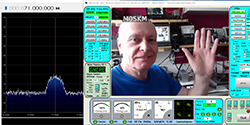Innovation is alive and well

71MHz DATV success
A key goal for amateur radio at the very heart of its licence definition is that it is “for the purpose of self-training in radio communications, including conducting technical investigations”.
Matching this is a key item in the RSGB’s strategy: “Research—promote active involvement in research and technical development.”
In an age where the costs of commercial equipment can be as little as £20 for a new and capable VHF/UHF FM handheld, some may wonder if the incentive to experiment and construct may have withered.
However, the sheer variety and low cost of equipment, sophisticated parts, free software and the advent of SDR, etc. has created unprecedented opportunities for those inclined to dabble, hack and innovate.
Across all our bands we have already witnessed the rise in digital modes, software and advanced equipment.
Unusually, compared to most countries, we have also been fortunate that as a Society we work closely with our regulator, Ofcom, and through this relationship have obtained access to special bands to foster some truly leading-edge developments.
Starting in 2014 we have gained footholds in 71MHz, 147MHz and bands above 275GHz.
We have worked closely with enthusiasts who have grabbed these opportunities to develop and demonstrate ground-breaking DATV in VHF, communications at 288GHz, etc.
Some of these developments are being fostered by the RSGB’s spectrum managers who are keen to show regulators that innovation is alive and well, justifying our place in the world—and, indeed, it is one of the key elements of our case for 50MHz at WRC-19.
Research is not confined to special ‘experimental’ bands.
In recent times we have seen burgeoning developments in digital modes, propagation beacon technology, a proliferation of software defined radios and so on.
“amateur research and innovation is far from over; indeed, we may well be at the dawn of its greatest era”
The annual update of the RSGB’s Band Plans is often driven by such technological change and achievement.
Another example is that we are now at the stage that regular QSO distances in the microwave bands can be way beyond the ability of the VHF talkback frequency—which may surprise many who have been taught that microwaves are only line of sight and go a few kilometres at the most.
In addition to the success in opening up 71MHz, other initiatives to spur innovation featured in the RSGB’s 2018 Band Plans, e.g. new designations for a more optimum high-frequency ‘WSPR successor’ and options for new high-speed data modes in the main 50, 144, 432 and 1240 MHz bands.
There is also, of course, plenty of space in the microwave bands to adapt and experiment with a bewildering choice of modules and parts available.
What we need are the volunteers or small teams to come forward and fulfil our hopes, desires and expectations—and there are prizes, RSGB Legacy funding and fame to be had for it.
Amateur research and innovation is far from over; indeed, we may well be at the dawn of its greatest era.
Category: RSGB Strategy 2022










